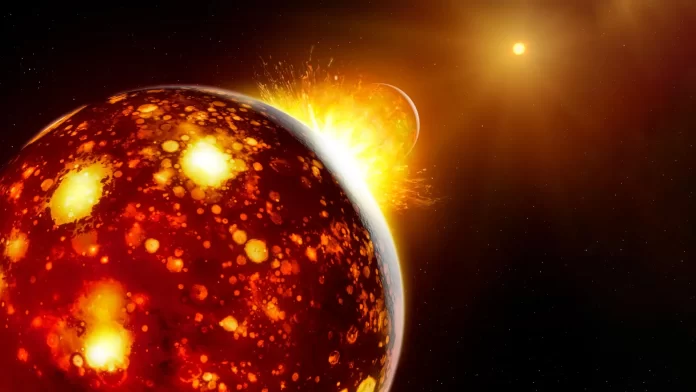- Reconstructing Theia’s makeup: A new study in Science identifies the most likely chemical composition of Theia, the ancient planetary body that collided with early Earth.
- Clues to its birthplace: Theia’s reconstructed composition points to an origin in the inner Solar System and suggests it formed even closer to the Sun than Earth.
- Moon rocks as evidence: Scientists analyzed lunar samples returned by the Apollo missions, using their precise iron isotope ratios for the first time to trace Theia’s origins.
About 4.5 billion years ago, a dramatic event transformed the young Earth when a large protoplanet known as Theia struck our planet. Scientists still cannot fully reconstruct the sequence of the impact or what followed, but the consequences are clear. The collision altered Earth’s size, structure, and orbit, and it ultimately led to the creation of the Moon, which has remained our constant companion in space ever since.
This raises several important questions. What kind of object collided with Earth so violently? How massive was Theia, what was it composed of, and from what region of the Solar System did it originate? These questions remain challenging because Theia did not survive the encounter. Even so, chemical clues linked to its existence persist within the modern Earth and Moon. A new study published on November 20, 2025, in Science and conducted by researchers from the Max Planck Institute for Solar System Research (MPS) and the University of Chicago uses these clues to reconstruct Theia’s likely composition and identify where it may have formed.
“The composition of a body archives its entire history of formation, including its place of origin.” Thorsten Kleine, Director at MPS and co-author of the new study
Isotopes as Records of a Body’s Ancient Origins
The proportions of certain metal isotopes provide valuable insight into a body’s past. Isotopes are different versions of the same element that vary only in the number of neutrons in the nucleus and therefore in their mass. In the early Solar System, these isotopes were not distributed evenly. Materials near the Sun contained slightly different isotope ratios than those formed farther out. As a result, a body’s isotopic makeup preserves information about the original region where its building materials formed.
Tracking Theia’s Signature in Earth and Lunar Rocks
In the new study, scientists measured iron isotope ratios in rocks from Earth and the Moon with a level of precision not achieved before. They analyzed 15 samples from Earth and six lunar samples returned by the Apollo missions. The findings were consistent with previous work on chromium, calcium, titanium, and zirconium isotopes: Earth and Moon show no measurable differences in these ratios.
This close match, however, does not directly reveal what Theia was like. Multiple collision models could still produce the same final outcome. In some scenarios, the Moon forms mostly from Theia’s material. In others, the early Earth contributes most of the material, or the two bodies mix so thoroughly that their individual signatures cannot be separated.
Reconstructing a Lost Planet from Chemical Evidence
To learn more about Theia, the team treated the Earth-Moon system like a puzzle that could be solved backward. By considering the identical isotopic signatures found in both bodies, they tested combinations of possible Theia compositions, sizes, and early Earth properties that could have produced the final state we observe today.
Their analysis included iron, chromium, molybdenum, and zirconium isotopes. Each element provides information about a different stage in planetary development.
Long before the collision with Theia, the early Earth experienced an internal differentiation process. As Earth’s metallic core formed, elements such as iron and molybdenum migrated inward and became concentrated there, leaving the mantle with much lower amounts. The iron now found in Earth’s mantle must therefore have arrived after the core formed, possibly delivered by Theia. Elements like zirconium, which remained in the mantle, record the full history of the planet’s formation.
Meteorites as Clues to Theia’s Birthplace
When the researchers compared all mathematically possible combinations of Theia and early Earth compositions, they found that some outcomes were highly improbable.
“The most convincing scenario is that most of the building blocks of Earth and Theia originated in the inner Solar System. Earth and Theia are likely to have been neighbors.” Timo Hopp, MPS scientist and lead author of the new study
The early Earth’s makeup can be explained mostly as a mix of known meteorite types. Theia is different. Meteorites originate from specific regions of the Solar System and act as reference points for the materials available during planet formation. In the case of Theia, the data suggest that its composition cannot be fully matched to known meteorite groups. Instead, the results indicate that some of Theia’s building material came from even closer to the Sun than Earth’s own source region. According to the team’s calculations, Theia most likely formed interior to Earth’s orbit before the two bodies eventually collided.



